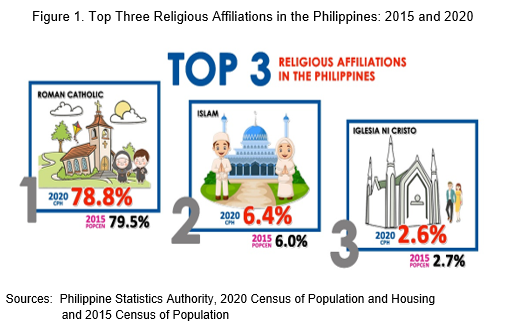

Among the country's 108,667,043 household population in 2020, 85,645,362 persons, or 78.8%, identified their religious affiliation as Roman Catholic, the 2020 Census of Population and Housing of the Philippine Statistics Authority (PSA) said.
Islam was the second among the most population of religious affiliation with 6,981,710 persons (6.4%), followed by Iglesia ni Cristo with 2,806,524 persons (2.6%).
These were also the top three religious affiliations back in the 2015 report.
"Completing the top ten religious affiliations in 2020 are Seventh Day Adventist, and Aglipay (0.8% each); Iglesia Filipina Independiente (0.6%); Bible Baptist Church (0.5%); and United Church of Christ in the Philippines, Jehovah’s Witness, and Church of Christ (0.4% each)," PSA said.

Bicol Region as most population of Roman Catholic
Of all 17 regions, Region V - Bicol Region reportedly has the highest proportion of Roman Catholics, 93.5% of its 6,067,290 household population.
Followed by Region VIII - Eastern Visayas with 92.3% and Region VII - Central Visayas with 90.5%.
The lowest proportion of Roman Catholics is Bangsamoro Autonomous Region in Muslim Mindanao (BARMM) which posted 5.3%.
Albay as province with highest proportion of Roman Catholics
Among 1.37 million households, 1.32 million persons, or 96.2%, were Roman Catholics.
"It was followed by Catanduanes (95.6%) and Eastern Samar (95.3%). Fourteen other provinces posted proportions higher than 90.0 percent," it read.
The top three provinces with the highest number of Roman Catholics are Cebu, with 3.14 million persons, Batangas with 2.72 million persons, and Camarines Sur with 1.92 million persons.
91 in every 100 BARMM residents are Islam
Islam is the most dominant religion in BARMM, with 4.49 million persons or 90.9% of the 4.94 million household population in the region.
Followed by Region IX - Zamboanga Peninsula with 18.2%, SOCCSKSARGEN with 15.8%, Region X - Northern Mindanao with 8.5%, and Region XI - Davao Region and MIMAROPA Region with 3.5% each.
The data was based on the information provided by the respondent pertaining to all members of the household.
Answered were collected by asking, "What is _____’s religious affiliation?"




